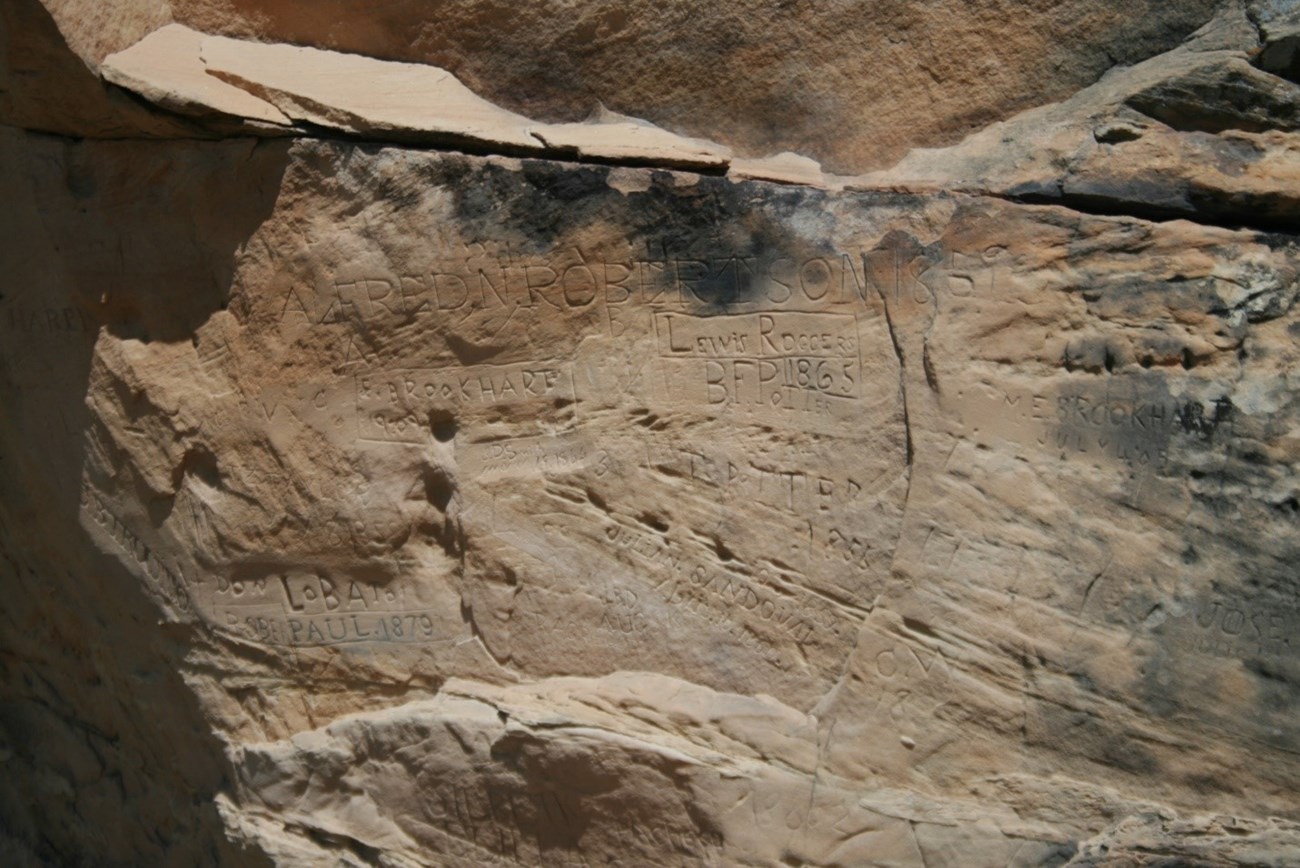Part of a series of articles titled National History Day.
Article
Project Ideas- Communication & National Historic Trails: Santa Fe Trail

Names of trail travelers carved into Autograph Rock.
Photo/NPS
Communication was an essential aspect of the Santa Fe Trail.
Below are a few examples and questions to get you thinking about potential research projects.
1. The Santa Fe Trail brought people from different cultures and backgrounds together.
- What role did cultural differences play in communication on the trail?
- How did people overcome language barriers to communicate?
- How does trade affect communication?
2. The Mexican War for Independence from Spain led to the opening of the Santa Fe Trail.
- How did communication play a role in wars and revolutions?
- Why might Spain have resisted communication and trade between the United States and Santa Fe? Why might Mexico have welcomed these same things?
3. Trail travelers relied on natural landmarks to guide them along the trail.
- How did landmarks serve as visual communication on the trail?
- What can the names of places along the trail communicate about the experience of travelers and traders?
4. Travelers carved their names in natural rock formations like Autograph Rock in Oklahoma.
- What can we learn from the “autographs” left behind?
- What did the “autographs” communicate to trail travelers?
5. The US government built military forts along the trail.
- What did the forts communicate to different groups who encountered them?
- How were forts connected to the process of treaty-making between the US government and various American Indian nations?
6. The trail crossed international and undefined borders.
- How did miscommunication over territorial borders cause conflict along the trail?
Example Project Idea
In 1821, a debt-ridden Missourian named William Becknell took a trip to Santa Fe, on the northern fringes of newly-independent Mexico. Thus began the official life of the Santa Fe Trail, a route pieced together out of various existing routes—including many established by American Indians—to connect the United States’ western frontier (and, later, the nation’s eastern markets and even international economies) with its neighbor to the south. The Santa Fe Trail facilitated cooperation, and sometimes collision, between the diverse array of people that made their homes somewhere along it.
---
“Considered as groups, sellers, buyers, and middle men (usually men), and the formal networks they shared are the usual variables of analysis for studying an economic system. However, when we do local history or archaeological work, or look at ethnographic accounts, it is clear that in actual practice trade in virtually all cases had a symbolic and social as well as economic component…. In fact, ‘trade’ and all its associated activities involved women, men, extended families, and created communities.”
Minette Church, “The Cultural Context of Commerce: Historical Anthropology and Historical Silences along the Mountain Branch of the Santa Fe Trail,” in Historical Archaeology through a Western Lens, eds. Mark Warner and Margaret Purser (Lincoln: University of Nebraska Press, 2017), 240.
---
Suggested primary sources:
• Josiah Gregg, Commerce of the Prairies
• "Captain William Becknell’s Journal of Two Expeditions from Boon’s Lick to Santa Fe," Wagon Tracks 11, no. 3 (May 1997): 1, 20-24 [note: reader will have to scroll down to the 3rd issue in this sequence; Becknell’s own words don’t start until page 20)
• “The Diary of Pedro Ignacio Gallego, wherein 400 soldiers following Comanches met William Becknell on his first trip to Santa Fe,” Wagon Tracks 7, no. 1 (November 1992): 1, 15-20 [note: Gallego’s own words don’t start until page 18]
Suggested digital archives:
• ‘Exhibits’ page of the Santa Fe Trail Center’s web site
• SFTA’s Wagon Tracks archive
Last updated: August 31, 2020
